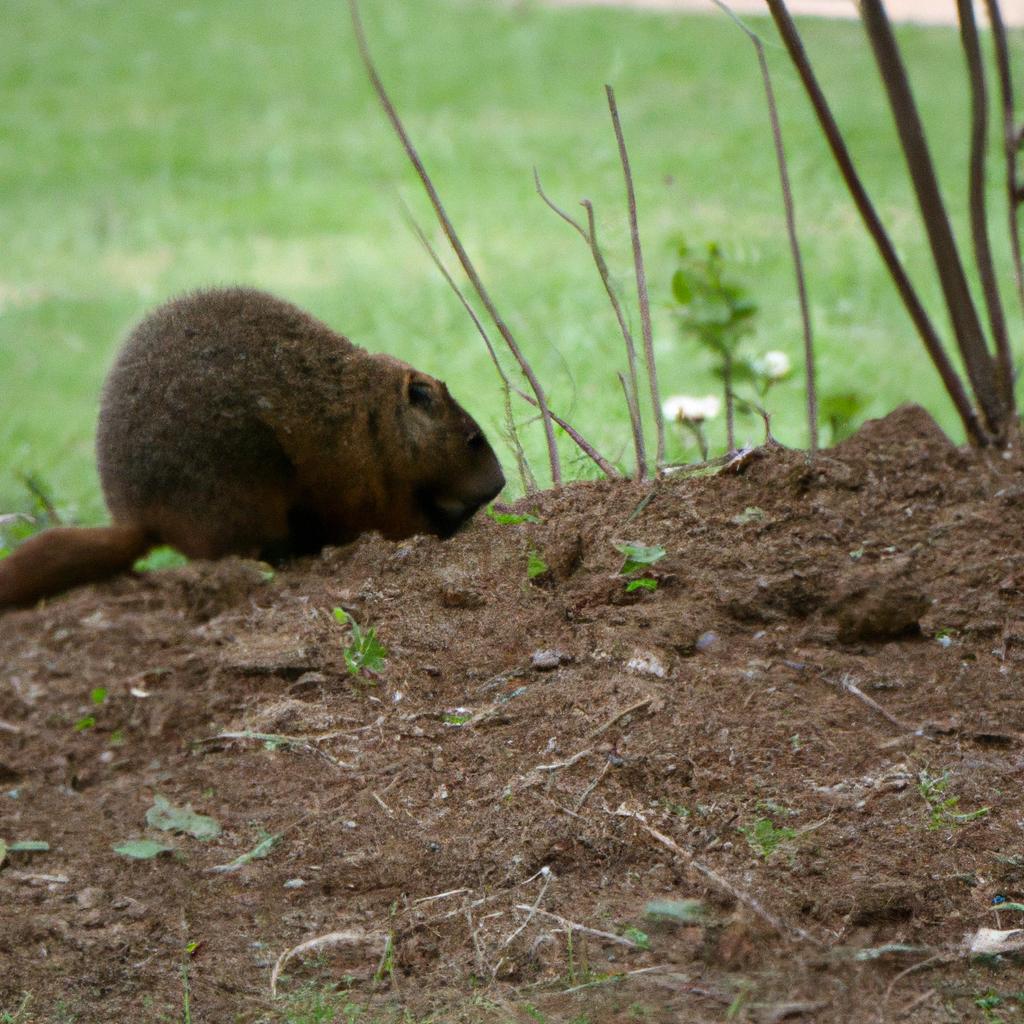As a backyard owner, I’ve always been curious about the wildlife that frequent my garden. One animal that often emerges from its burrow is the groundhog (Marmota monax), also known as a woodchuck.
Recently, I found myself wondering, “Do groundhogs eat grubs?” After researching and observing these fascinating creatures, I’ve discovered the answer, which I’m excited to share with you in this blog post.
In short, yes, groundhogs do eat grubs, but this is not their primary food source.
In this post, I’ll explain when, how, and why groundhogs eat grubs, and the implications for us backyard owners.
I’ll also discuss other animals that might eat grubs.
Contents
Groundhogs’ Natural Diet
Groundhogs are primarily herbivores, meaning they mainly eat plant material.
Their preferred diet consists of grasses, clover, dandelions, and other wild plants.
They also enjoy eating vegetables and fruits that grow in our gardens, such as beans, peas, tomatoes, and berries.
That being said, they have been known to eat insects, primarily grubs, when other food sources are scarce.
When Do Groundhogs Eat Grubs?
Groundhogs will eat grubs if they come across them while foraging for food. This is more likely to occur during the spring and summer months, when groundhogs are most active and grubs are more abundant.
However, groundhogs are opportunistic feeders, so they will eat grubs whenever they find them, regardless of the season.
How Do Groundhogs Find Grubs?
Groundhogs have an excellent sense of smell, which helps them locate food sources both above and below ground. They can detect grubs that are buried in the soil and will dig them up to eat.

Groundhogs are also known to eat grubs they find on the surface of the ground, such as those that have been disturbed by human activity or other animals.
How Often Do Groundhogs Eat Grubs?
As previously mentioned, groundhogs primarily consume plant material and only eat grubs opportunistically.
Grubs make up a very small portion of their diet, so it is not common for groundhogs to eat them regularly.
However, if other food sources are scarce, groundhogs may eat grubs more frequently as a supplemental source of nutrition.
Why Do Groundhogs Eat Grubs?
Grubs provide groundhogs with a source of protein, which is essential for their growth and overall health. Although groundhogs predominantly consume plant material, they will occasionally eat grubs to meet their protein needs.
Additionally, eating grubs can help groundhogs maintain a balanced diet, as it provides them with a variety of nutrients that they may not get from plants alone.
Implications for Backyard Owners
The fact that groundhogs eat grubs can be both a blessing and a curse for backyard owners.
On one hand, groundhogs can help to control grub populations in your lawn and garden, which can be beneficial in preventing damage to your plants and grass.
On the other hand, groundhogs’ burrowing activity can cause damage to your lawn, garden, and even the foundation of your home.
It is important to remember that groundhogs are a natural part of the ecosystem, and their presence in your backyard can be an indicator of a healthy environment. Although it may be tempting to see groundhogs as a nuisance, it is essential to recognize the role they play in maintaining the balance of nature.
Other Animals That Eat Grubs
Groundhogs are not the only animals that eat grubs.
Other creatures that consume grubs include:
- Birds, such as robins, starlings, and bluebirds
- Insect-eating mammals, such as moles, shrews, and hedgehogs
- Amphibians, such as frogs and toads
- Reptiles, such as turtles and some species of snakes
These animals all play a role in controlling grub populations and maintaining the balance of the ecosystem.
How To Keep Groundhogs Out Of Your Yard!
There are several things that can be done to prevent groundhogs from digging and eating stuff in your backyard. I will list some of the strategies below.
Also, see my recent post if you want a full list of my favorite methods to keep groundhogs and gophers away!
1. Using ultrasonic sound
Groundhogs, like other bigger mammals that may invade your garden, tend to have very good hearing. This means that loud or consistent noises will scare them away or at least shorten their visits.
Check out my full buying guide for these ingenious ultrasonic repeller devices here!
One of my favorite technologies to keep pests away from my backyard is these cool solar-powered ultrasonic sound emitters that you can buy right from Amazon! In my experience, they really work, and the solar panels on top save you the time and money of changing batteries all the time.
They will also work against other rodents like gophers, mice, and rats!
2. Sprinkling natural repellents
Groundhogs may be scared off by using natural scents such as coyote urine or predator scents.
They may also cause them to leave if there is a combination of sounds being played from a radio. The sounds include the sound of barking dogs and coyotes.
You can sprinkle dog hair, cayenne pepper or strong enteric oils and other natural repellents around the garden to keep the groundhogs away.
See my complete list of humane ways to keep groundhogs away from your yard for more tips and tricks!
3. Fencing around the garden
You can also fence around your garden to keep groundhogs from entering the garden. It should be at least 3 feet deep and have a double row of fencing.
Groundhogs are good diggers so it has to go underground or they may find a way into the garden even with the fences in place!
4. Using live traps
You can use a live trap to capture groundhogs and move them to another area. Live trapping is currently the most humane way of groundhog control. Once you have removed all groundhogs from an area, it is important to ensure that they do not come back by using fencing or other barriers to block access.
You can also just buy a live trap, as the sturdy metal ones shown here:
To lure the groundhogs in, you can use one of the numerous favorite foods of groundhogs or an optimized extra attractive formula like this one to make the catch even quicker!
5. Using natural pesticides
There are pesticides or rodent toxins that can be used to kill groundhogs on your property. These may also affect other animals in the area so it is important to ensure that they are only sprayed on the targeted plants.
I do not recommend these, as I prefer more humane ways as described here. Also, anything that kills an animal will also harm humans to some degree, so go for a repellant rather than a toxin if you go the chemical route!
6. Using Scarecrows
You can use a scarecrow in your garden to keep groundhogs away. Groundhogs are afraid of novelty so time-sensitive or motion-activated scarecrows may also be effective in keeping them out of the garden.
7. Using Lights
Groundhogs are not strictly nocturnal animals but they are most active at low light so they do avoid areas with bright lights.
Motion-activated lights, sounds, and sprinklers may help prevent groundhogs from entering your yard.
Any blinking light will confuse and scare away groundhogs from your yard, especially if they are motion activated and sudden!
8. Motion-activated sprinklers
Like most animals, groundhogs hate surprises, and they will run away if suddenly sprayed with water. I like this solution because it is humane, simple, effective, and does not require much time to set up.
The Havahart 5277 is a motion-activated sprinkler that is activated by the movement of animals up to 25 feet away and sprays them with a harmless water jet, frightening them off and keeping them at bay.
The included metal stake makes it easy to install in your garden, and the sprinkler can be rotated 180 degrees for maximum coverage.
## Conclusion
In summary, groundhogs do eat grubs, but this is not their primary food source.
They will consume grubs opportunistically, particularly if other food sources are scarce.
Groundhogs’ consumption of grubs can have both positive and negative implications for backyard owners, as it can help control grub populations while also causing damage to lawns and gardens.
Understanding the role that groundhogs play in the ecosystem can help us appreciate their presence and value their contributions to the environment.















